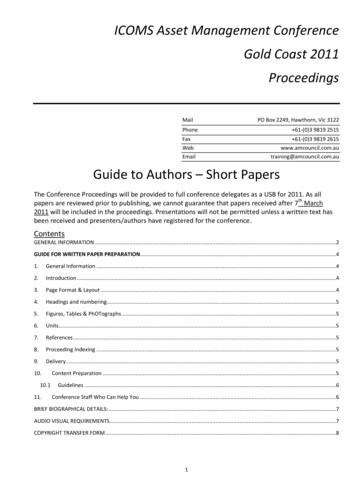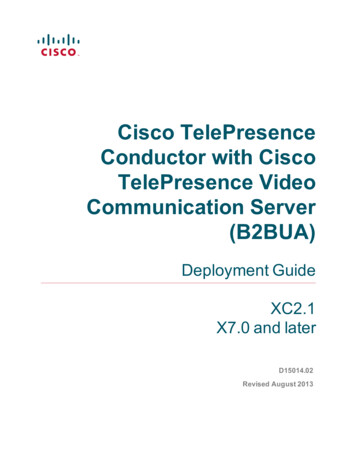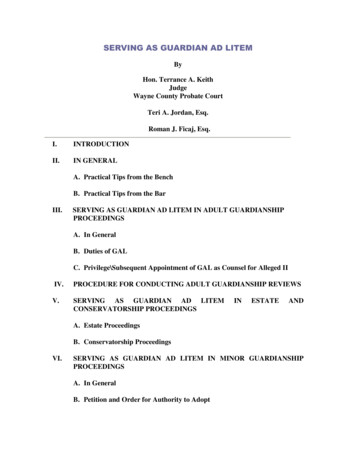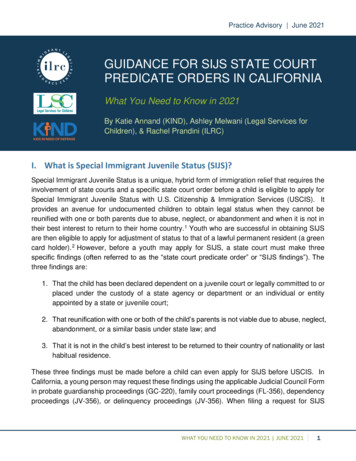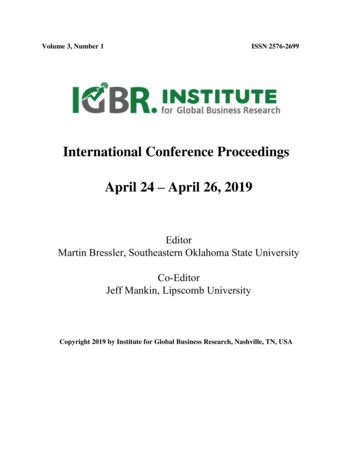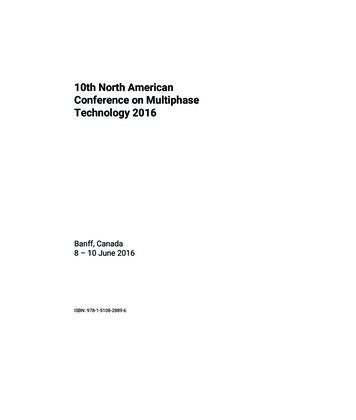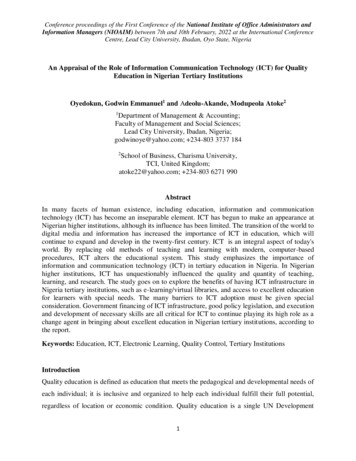
Transcription
Conference proceedings of the First Conference of the National Institute of Office Administrators andInformation Managers (NIOAIM) between 7th and 10th February, 2022 at the International ConferenceCentre, Lead City University, Ibadan, Oyo State, NigeriaAn Appraisal of the Role of Information Communication Technology (ICT) for QualityEducation in Nigerian Tertiary InstitutionsOyedokun, Godwin Emmanuel1 and Adeolu-Akande, Modupeola Atoke21Department of Management & Accounting;Faculty of Management and Social Sciences;Lead City University, Ibadan, Nigeria;godwinoye@yahoo.com; 234-803 3737 1842School of Business, Charisma University,TCI, United Kingdom;atoke22@yahoo.com; 234-803 6271 990AbstractIn many facets of human existence, including education, information and communicationtechnology (ICT) has become an inseparable element. ICT has begun to make an appearance atNigerian higher institutions, although its influence has been limited. The transition of the world todigital media and information has increased the importance of ICT in education, which willcontinue to expand and develop in the twenty-first century. ICT is an integral aspect of today'sworld. By replacing old methods of teaching and learning with modern, computer-basedprocedures, ICT alters the educational system. This study emphasizes the importance ofinformation and communication technology (ICT) in tertiary education in Nigeria. In Nigerianhigher institutions, ICT has unquestionably influenced the quality and quantity of teaching,learning, and research. The study goes on to explore the benefits of having ICT infrastructure inNigeria tertiary institutions, such as e-learning/virtual libraries, and access to excellent educationfor learners with special needs. The many barriers to ICT adoption must be given specialconsideration. Government financing of ICT infrastructure, good policy legislation, and executionand development of necessary skills are all critical for ICT to continue playing its high role as achange agent in bringing about excellent education in Nigerian tertiary institutions, according tothe report.Keywords: Education, ICT, Electronic Learning, Quality Control, Tertiary InstitutionsIntroductionQuality education is defined as education that meets the pedagogical and developmental needs ofeach individual; it is inclusive and organized to help each individual fulfill their full potential,regardless of location or economic condition. Quality education is a single UN Development1
Conference proceedings of the First Conference of the National Institute of Office Administrators andInformation Managers (NIOAIM) between 7th and 10th February, 2022 at the International ConferenceCentre, Lead City University, Ibadan, Oyo State, NigeriaProgramme objective (SDG4) focusing only on education, with the purpose of ensuring inclusiveand equitable quality education and promoting lifelong learning (Sean Slade, 2017). Education isdescribed as the process of gaining or enabling information, skills, values, morals, beliefs, habits,and personal growth. It is a potent tool for social, political, and economic improvement, withoutwhich no individual or society can achieve professional advancement. It is the foundation forhuman progress and civilisation. Tertiary education, which includes post-secondary education, isthe third layer of the educational system.Tertiary education is defined by the Federal Republic of Nigeria (2014) as education providedbeyond secondary school at universities, colleges of education, polytechnics, and monotechnics,as well as institutions that provide correspondence courses. Tertiary education is critical forpromoting growth, alleviating poverty, and increasing shared prosperity. It is highly significantsince it benefits not just the person but the entire community. The integration of ICT into highereducation allows students to access more sophisticated and broad fields of study in order toimprove their analytical skills. ICT is an essential component of today's world. It's a force that'saltered many elements of people's lives. ICT has had a massive influence on all disciplines duringthe last two or three decades. The use of ICT in education as a way of improving skills andincreasing capacity for economic growth is crucial to bringing about sustainable improvements inthe educational system (Damkor Matthew, Irinyang Danjuma Joro, Haruna Manasseh 2015).Professionals in the field of education have stated that when correctly employed, ICT hasenormous potential for improving teaching and learning, resulting in the expected qualityeducation.Nigeria has demonstrated consistent its commitment to the SDGs promise via leadership andownership of the implementation process, as it strives to maintain its leadership role in Africa andthe globe at large. In order to achieve SDG4, significant efforts have been made to focus greaterattention on improving education, particularly in Nigerian tertiary institutions. Adoption of ICT inNigeria's tertiary education is one of the ways to achieve this. The ICT is a priceless contemporaryintervention. Its intrinsic characteristics, including as precision, high-speed performance,dependability, and the capacity to store extremely vast volumes of data, have allowed it to be used2
Conference proceedings of the First Conference of the National Institute of Office Administrators andInformation Managers (NIOAIM) between 7th and 10th February, 2022 at the International ConferenceCentre, Lead City University, Ibadan, Oyo State, Nigeriato all human endeavors, including education and research. This research aims to assess the functionof ICT as a motivator for excellent education in Nigeria's higher institutions.Review of Related LiteratureConceptual ClarificationEducationEducation is a crucial national development investment. It is the process of acquiring knowledge,which encompasses all of the processes through which an individual develops talents, attitudes,and other types of behavior that are beneficial to the society in which he or she lives(Oluwagbohunmi, 2013). It is the transmission of culture in terms of continuity and expansion, orthe dissemination of information to ensure the logical direction of society, or both" (Adu,Emunemu, & Oshati, 2014). The importance of education in development cannot be overstated,since it provides the drive for development to harness human resource development and materialresources (World Bank, 2005). Education is compatible with national growth in this way.Sustainable education's revolutionary potential boosts national development. This just supports theargument that education is critical to national growth.Tertiary Education in NigeriaThe federal, state, and municipal governments in Nigeria are in charge of education. Nigeria'seducation system is divided into three tiers: basic education, post-basic/senior secondary education,and post-secondary/tertiary education. The Federal Ministry of Education is in charge of generalpolicy formation and quality supervision. The National University Commission (NUC) is agovernment-run body that governs higher education administration in Nigeria (Nina Arnhold2021). Tertiary education encompasses all forms of official post-secondary education, includingpublic and private universities, colleges, technical training institutions, and vocational schools.The development of applicable high-level personnel, the growth of individual intellectual potential,and the learning of physical and intellectual skills are all purposes of higher education. These aimsare pursued by tertiary educational institutions through teaching, research, knowledge3
Conference proceedings of the First Conference of the National Institute of Office Administrators andInformation Managers (NIOAIM) between 7th and 10th February, 2022 at the International ConferenceCentre, Lead City University, Ibadan, Oyo State, Nigeriadevelopment, and dissemination, which they do through a range of programs such as certificate,diploma, undergraduate, and postgraduate courses (Oyebade & Dike, 2013).University education, in particular, helps to produce high-level workers in a variety of professionalfields, as determined by national development needs. University education also focuses onbuilding a sense of community among students through projects and action research. Tertiaryeducation is in high demand, owing to a growing awareness of its value for a country's economicand socio-cultural growth, among other factors. Tertiary education enriches society as a whole,not just the individual. It helps to promote growth, reduce poverty, and increase shared wealth.In any civilization, a highly trained workforce with lifetime access to a quality tertiary educationis required for innovation and progress. Graduates with higher education are more ecologicallyconcerned, have better habits, and participate in civic activities at a higher rate. Increased taxrevenues from greater salaries, healthier children, and smaller families all contribute to nationsbeing stronger (Terlumun Mark Ijov and Wombu Ruth Nguzan, 2019). In short, higher educationinstitutions equip people to be active citizens of their communities and societies in addition toproviding them with necessary and relevant employment skills (Nina Arnold, 2021).Quality EducationThe term "quality education" refers to a form of education that is concerned with its quality. Ineducation, quality implies "fitness for purpose," which means that the quality of education in anycommunity must be measured against what that culture views to be the aim of education(Anikweze 2011). The clarified objectives of section 20 of the 1979 Nigeria constitution state thatthe educational system shall be of the type that motivates and stimulates creativity and drawsheavily on our traditions of moral principles that include honesty for positive Nigerian moral andreligious values, ensure consistency of traditional family values and their progressive upgradingto meet modern concept, produce professional competence and a decided to order society, and soon. This means that the educational system should assist students in developing the habits, skills,opinions, tastes, and virtues required for the maintenance of our cultural norms and the thriving ofmoral principles (Oluwagbohunmi, 2013).4
Conference proceedings of the First Conference of the National Institute of Office Administrators andInformation Managers (NIOAIM) between 7th and 10th February, 2022 at the International ConferenceCentre, Lead City University, Ibadan, Oyo State, NigeriaThe capacity of a school to offer the essential facilities to enhance teaching and learning that canlead to the attainment of educational goals in accordance with mandated accepted worldwidestandards is referred to as quality education (Pius & Aii, 2019). It is an investment in individualswith significant societal benefits. One of the United Nations Development Programme's (UNDP)Sustainable Development Goals (SDG 4) agreed in 2015 is quality education. By 2030, it aims tooffer universal access to high-quality education and encourage lifelong learning across the world(Slade, 2017). In a statement in support of the SDGs and the pursuit of quality education for all,the Association for Supervision and Curriculum Development (ASCD) and EducationInternational (EI) defined quality education as education based on the child benefit of the entire,that is, the social, mental, emotional, physiological, and cognitive development of each studentirrespective of gender, race, ethnicity, economic status, or geographical area. It not only preparesthe youngster for testing or examination, but also for life.Quality education provides resources and directs policy to ensure that each child enters schoolhealthy and learns about and practices a healthy lifestyle; learns in an environment that isphysically and emotionally safe for students and adults; is actively engaged in learning and isconnected to the school and broader community; has access to personalized learning and issupported by qualified, caring adults; and is challenged academically and prepared for success incollege or further study and employment and participation in a global environment. Qualityeducation provides the outcomes needed for individuals, communities, and societies to prosper. Itallows schools to align and integrate fully with their communities and access a range of servicesacross sectors designed to support the educational development of their students. Each child entersschool healthy and learns about and practices a healthy lifestyle; learns in a physically andemotionally safe environment for students and adults; is actively engaged in learning and relatedto the school and broader society; has access to essential learning and is substantiated by qualified,responsible adults; and is challenged scholastically and equipped for success in co-curricularactivities. Individuals, communities, and society prosper when they have access to high-quality5
Conference proceedings of the First Conference of the National Institute of Office Administrators andInformation Managers (NIOAIM) between 7th and 10th February, 2022 at the International ConferenceCentre, Lead City University, Ibadan, Oyo State, Nigeriaeducation. It helps schools to align and integrate fully with their communities, as well as access avariety of resources from many sectors that promote their kids' educational growth.Information Communication Technologies (ICT)ICTs are technologies that employ electronic methods to transmit, alter, and store data. E-mail,SMS, text messaging, and video chat (e.g., cellphones, desktops, and laptops) are examples ofcommunication and information technologies (Mathevula & Uwizeyimana, 2014).Computers, software, networks, satellite linkages, and associated systems are referred to as ICT.They allow individuals to access, analyze, create, share, and use data, information, and knowledgein previously inconceivable ways (Barakabitze et al, 2019). It refers to telecommunications-basedtechnologies that give information access. The internet, wireless networks, cell phones, and otherforms of communication are all examples of this. ICT is cutting-edge and active. It has transformedsociety into a global village over the previous few decades by providing a huge array ofcommunication options. It has handled information effectively and efficiently using a variety oftechnical tools and resources, and it is quietly contributing to society's general growth anddevelopment. ICT has been identified as a worldwide driver for change. In current day ofglobalization, it is a necessary component of the growth of every aspect of any nation. In thetwenty-first century, it is acting as a catalyst for change in the manner and quality of learning inacademic institutions across the globe. It has quickly become one of the fundamental buildingblocks of modern society.ICT and EducationThe use of ICT in education as a way of improving skills and increasing capacity for economicgrowth is crucial to bringing about sustainable improvements in the educational system (AduwaOgiegbaen & Iyamu, 2005). Computers and their peripherals such as printers, software, scanners,and projectors are used in education to teach and learn. Indeed, ICT represents a paradigm changein how humans use computers and the internet to interpret information. It has changed the modelof information sharing from static to dynamic. The integration of ICT into higher education allowsstudents to access more sophisticated and broad fields of study in order to improve their analytical6
Conference proceedings of the First Conference of the National Institute of Office Administrators andInformation Managers (NIOAIM) between 7th and 10th February, 2022 at the International ConferenceCentre, Lead City University, Ibadan, Oyo State, Nigeriaskills. Because of its dynamic interactive and interesting content, ICT improves teaching andlearning. It has the ability to stimulate, enrich, and strengthen skills, engage and motivate students'learning, aid to link school knowledge to work procedure, and help to develop economic potentialfor today's workers; it adds to the tertiary institution's developmental process; it enhances studentlearning; and it creates opportunities for correlation between the higher education institution andthe rest of the world (Dave & Tearle, 2010). Through a range of technologies to enhance andfacilitate instructors' professional activities, ICT may help tertiary institutions become moreefficient and productive (Adeoye, Oluwole, & Loto, 2013). It allows students to contact with eachother via e-mail, mailing lists, chat rooms, and other means. It allows for faster and moreconvenient access to more comprehensive and up-to-date information. ICT may also be utilized tocomplete more difficult jobs since it offers researchers with a consistent means of disseminatingresearch papers and conclusions (Owoyale-Abdulganiy & Olaniyii, 2021). Ghavifekr, Kunjappan,Ramasamy, & Anthony (2016) described th three important motivations for ICT in education, asfollows:i.As a tool for resolving issues in effectively teaching: ICT provides the capabilities foreffective teaching and learning delivery, management, and support.ii.ICT can change the content, methods, and overall quality and quantity of teaching andlearning, reducing teachers' workload and ensuring constructivist inquiry-orientedclassrooms; and iii. As a central force throughout economic competitiveness:iii.As a crucial component in economic and social shift patterns that have technological skillsimportant to today's students' employment prospects.Theoretical ReviewTheory of TechnologyAcceptance Model (TAM)The technology acceptance model (TAM) is a theory of information systems that describes howpeople adopt information systems. It asserts that users' behavioural intentions, which are definedby the perception of technology's utility in accomplishing the job and perceived ease of use, predictusers' adoption of technology.7
Conference proceedings of the First Conference of the National Institute of Office Administrators andInformation Managers (NIOAIM) between 7th and 10th February, 2022 at the International ConferenceCentre, Lead City University, Ibadan, Oyo State, NigeriaIt was one of the most important models of technology adoption, developed by Fred Davis andRichard Bagozzi (1989), with two major elements affecting an individual's desire to utilize newtechnology: perceived ease of use and perceived utility. An older adult who views digital gamesas too difficult to play or a waste of time is unlikely to want to learn how to use them, but an olderadult who views them as offering required mental stimulation and being simple to learn is morelikely to want to learn how to use them. TAM has been challenged for a variety of reasons, but itis a helpful overall framework that is compatible with a number of studies on the elements thatimpact older individuals' willingness to embrace new technology (Braun, 2013). This theory iswell-placed in this research since the goal of the study was to assess the impact of informationtechnology in attaining excellent education in Nigerian tertiary institutions.Empirical ReviewIfeakor (2021) investigated the impact of information and communication technology (ICT) onteaching and learning English in Nigerian tertiary institutions during the COVID-19 pandemic.During the COVID-19 epidemic, the research looked at the impact of adopting ICT in teachingand studying English in Nigerian postsecondary institutions. The study found that students coulddo very well using one or both of the mediums of classroom instruction because academicachievement is regardless of the media, institutions that really do not incorporate ICT intolearning are now embracing this technology, and ICT learning can completely consider replacingclassroom experience of the English language. According to the findings, greater effort should bedone to improve the learning process in general and prepare for future pandemics like this one.In the middle of the COVID-19 pandemic in Kwara State, Owoyale-Abdulganiy and Ayuba (2021)investigated the use of information and communication technology for teaching Islamic studies.During the Covid-19 lock-down in Kwara State, Nigeria, the research looked into the use ofinformation and communication technology (ICT) tools for teaching and studying Islamic studies.The three senatorial districts of the state were sampled using a basic random sampling approach.Smartphones, radio, television, and a variety of programs like as Whatsapp, Zoom, Telegram,Facebook, Google, 2go, Twitter, Instagram, and a slew of others were all heavily utilized to teach8
Conference proceedings of the First Conference of the National Institute of Office Administrators andInformation Managers (NIOAIM) between 7th and 10th February, 2022 at the International ConferenceCentre, Lead City University, Ibadan, Oyo State, Nigeriaand learn Islamic studies in Kwara State during the Coronavirus lock-down. It was proposed thatin order to improve the effectiveness and efficiency of Islamic studies teaching and learningthrough virtual learning, instructors and students should receive extensive training on how to makethe most use of ICT resources.During the COVID-19 Pandemic, Alaa and Abd Rahman (2020) investigated the impact of ICT onknowledge sharing among academic staff. The influence of ICT and ICT infrastructure onknowledge sharing among academic personnel was investigated in this study. The stratified sampleapproach was used in this investigation. ICT and ICT infrastructure have a favorable andconsiderable influence on Knowledge Sharing among academic staff at Iraqi public institutions.The research proposed that the government and universities work together to strengthen andimprove ICT infrastructure, which would boost both the reputation and ranking of Iraqi institutions.During the COVID-19 Pandemic, Alaa and Abd Rahman (2020) investigated the impact of ICT onknowledge sharing among academic staff. The influence of ICT and ICT infrastructure onknowledge sharing among academic personnel was investigated in this study. The stratified sampleapproach was used in this investigation. ICT and ICT infrastructure have a favorable andconsiderable influence on Knowledge Sharing among academic staff at Iraqi public institutions.The research proposed that the government and universities work together to strengthen andimprove ICT infrastructure, which would boost both the reputation and ranking of Iraqi institutions.Kehdinga (2019) investigated the role of ICT in African higher education. The study looked at therole of ICT and its capacity to improve education quality in African higher education institutions.The study discovered the benefits of having ICT infrastructure at higher education institutionsacross Africa, such as e-learning/virtual libraries, and access to excellent education throughcustomized tools for physically challenged students. The study found that government funding ofICT infrastructure is critical for improving the quality of education in tertiary institutions, and itrecommended that the government implement ICT policies, provide adequate funding for ICTinfrastructure, and monitor ICT infrastructure in various tertiary institutions to ensure that ICTappliances is not neglected but is in use.9
Conference proceedings of the First Conference of the National Institute of Office Administrators andInformation Managers (NIOAIM) between 7th and 10th February, 2022 at the International ConferenceCentre, Lead City University, Ibadan, Oyo State, NigeriaThe Impact of ICT on Tertiary Institutions was investigated by Ijov and Wombu (2019). The studylooked at the varied effects of ICT on tertiary institutions as well as the primary roadblocks to ICTuse and implementation in higher institutions. According to the study, tertiary institutions shouldbe equipped with modern and advanced technological infrastructure to allow for the effective useof appropriate technologies for teaching and learning programs, and government at all levelsshould make adequate funds and resources available, particularly for the funding and sustainabilityof tertiary education.Mailuno and Mimi (2019) looked at Nigeria's Vision 20:2020 and the Implications of QualityEducation in Nigeria for Sustainable Development. The study looked at education as a concept, aswell as quality education, national stability, and long-term growth. The study concluded thatNigeria's vision to re-energize the education sector and restore the country's educational standardsis consistent with the Transformation Agenda and the Vision 20-2020 of the Federal Republic, andthat the noble policies of the Transformation Agenda and the Vision 20-2020/Vision 15- 2050 ofthe Federal Republic of Nigeria should be religiously followed and implemented, as well as theissue of quality assurance in the educational sector.ICT Awareness among Faculty Members of Pakistan's Public Sector Women Universities wasresearched by Shahida and Kiran (2018). The study looked at faculty members' knowledge,attitudes, and skills in using ICTs at Pakistani women's institutions. The research employed aquestionnaire-based survey design. Faculty members have a good attitude toward computers,although they have a poor degree of competency in utilizing ICTs, according to the survey. Thestudy stated that faculty members at Pakistan's public sector women's universities are aware of theneed for and importance of ICTs in the education sector, and that the institution should provideICT training for them so that they may influence the country's future.The role of ICT in the Nigerian educational system was investigated by Damkor, Irinyang, andHaruna (2015). The study looked on the role of ICT in Nigeria's educational system. According tothe research, Nigeria still has a long way to go in terms of implementation, which is widening thedigital and knowledge gaps, and access to ICT infrastructure remains a key concern for mostAfrican nations. Despite the importance of ICT in education, the study found that Nigerian schools10
Conference proceedings of the First Conference of the National Institute of Office Administrators andInformation Managers (NIOAIM) between 7th and 10th February, 2022 at the International ConferenceCentre, Lead City University, Ibadan, Oyo State, Nigeriahave yet to fully use technology for teaching and learning. Efforts to integrate ICT into theeducational system have had little impact, and it has been recommended that the governmentshould post and give ICT-skilled instructors to each school to impart ICT skills to students, as wellas stabilize Nigeria's energy supply.MethodologyThis is an exploratory study that considers the educational sector's experiences, perspectives, andsocially constructed realities in Nigeria. The study takes a secondary research strategy, in whichthe researchers make their decisions fully based on a survey of the literature on the use of ICT toattain excellent education in Nigerian tertiary education.Discussion of FindingsRole of ICT in Quality Education in Nigeria Tertiary InstitutionsIn Nigeria, the integration of ICT into higher education institutions is progressively taking shape,with some institutions recognizing its potential to improve, enrich, and support both professorsand students in their teaching and learning processes (Murgor, 2015). Recognizing the significanceof ICT in the development of skills, talents, and competencies for successful development, theFederal Republic of Nigeria's National Policy on Education (the Federal Republic of Nigeria, 2018)recommends that it be incorporated into education in Nigeria at all levels. Computers, the internet,television, radio, video conferencing, and mobile learning are all used to integrate (Lubega, 2017).Government and non-governmental organizations, such as banks, as well as individuals, havecontributed to the deployment of ICT in Nigerian Tertiary Schools. Firms such as the NigeriaCommunications Commission (NCC), Education Trust Funds (ETF), MTN Nigeria, and ZinoxComputers, for example, have shared laptops and other ICT gear with instructors and students athigher institutions at various intervals and at different periods. In Nigerian higher institutions, theuse of ICT for excellent education is pervasive and ubiquitous.ICT has been determined to have had a significant impact in upgrading and modernizing theprocedures and methods utilized in the management and administration of higher institutions. Themajority of administrative and clerical tasks, such as admissions processing, course registration,11
Conference proceedings of the First Conference of the National Institute of Office Administrators andInformation Managers (NIOAIM) between 7th and 10th February, 2022 at the International ConferenceCentre, Lead City University, Ibadan, Oyo State, Nigeriafee payment, and academic material procurement, have been computerized and are now completedremotely. Most postsecondary schools offer websites where students may accomplish a variety oftasks on their own and submit them to the university remotely. In Nigeria, the majority of tertiaryeducation institutions are currently using ICTs to handle the majority of their administrativeconcerns as well as deliver qualitative and quantitative guidance. Previously paid in cash or bybank draft, tuition, lodging, and other charges are now primarily paid online. This means that whenICT is applied at tertiary institutions, administrative services are delivered faster and moreeffectively, increasing the efficiency and efficacy of the institutions' service delivery.Researchers efficiently use ICT at tertiary institutions as a source of knowledge and a reliable wayof acquiring research materials, which benefits students in their studies by expanding the frontiersof learning beyond traditional classro
Conference proceedings of the First Conference of the National Institute of Office Administrators and Information Managers (NIOAIM) between 7th and 10th February, 2022 at the International Conference Centre, Lead City University, Ibadan, Oyo State, Nigeria 3 to all human endeavors, including education and research.



